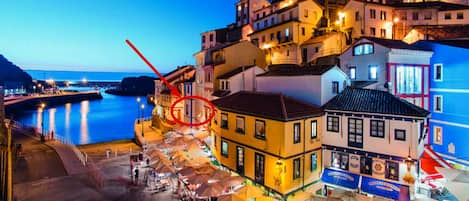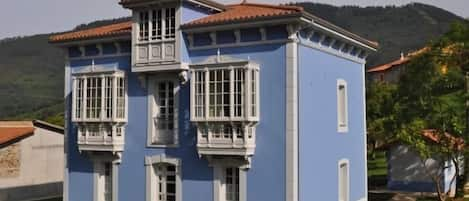Three-story tower of the nineteenth century, rebuilt on medieval remains next to the town hall, former "Palación de los Omaña", feudal lords of Cudillero for centuries. On the other side, the amphitheater of Cudillero: houses of fishermen staggered in the semicircular mountain and open to the port. Epicenter of the town, heart of the marine environment. The Torre del Palación belongs CASAS CudilleroVIP together with La Nana del Mar.
This is a vintage house, 100 square meters restored keeping the original structure, furniture and facilities. I have added contemporary art and some family antiques. Some pieces date back 4 centuries. There are old embroidered bed sheets, lamps and all kinds of exclusive things. The tower is the kilometer zero of Cudillero, 100 meters from the old harbor and in front of the famous amphitheater perched on steep hillsides with old and colorfull fishermen´s houses and stone stairs instead of streets.
Legend says Cudillero was founded by the Vikings. Its people speak Spanish as well as a dialect called Pixueto (with a resemblance to the language of the Vikings, according to some experts.). Whaling was practiced there until the 18th century.
There are pre-Romanic archeological remains and well-preserved 16th-century architecture. Among its outstanding monuments is the Quinta de Selgas palace, a splendid 19th-century home with fabulous and extensive gardens, paintings by Goya, opulent furnishings and its famous Tapestry Pavilion…
Cudillero’s cuisine enjoys a well-deserved fame, especially its fish and seafood (various species of crab, barnacles, lobster…) cooked in several traditional ways and enjoyed in simple restaurants right at the seaside. The village is also near 800 meter-high coastal mountains with a rich ethnographic heritage and a gastronomy based on meat and greens. The mountains are the home to the famous vaqueiros de alzada, or cattle herders, a social-ethnic group that has been the subject of numerous historical speculations. The local church of San Martín de Luiña preserves an inscription proclaiming: “Vaqueiros are not allowed to attend Mass,” testimony to the discrimination they suffered. Part of the spectacular and rugged coast of cliffs, beaches and hidden coves is an officially Protected Landscape, and the nearby Las Dueñas peatland is a Natural Monument.
Camino de Santiago (Coast Route): The Saint James Route, named The Northern Route, passes through Cudillero, (295 km from Santiago de Compostela), and is the oldest road to Santiago, dating from the 9th century .










